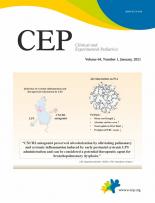Sepsis refers to a systemic infection involving the bloodstream that is of bacterial, viral, or fungal origin. Sepsis, a major threat to global health, was declared a key healthcare priority by the World Health Organization [1]. Sepsis peaks in extreme age groups, including the neonatal population. A relatively immature cellular and humoral immune system, poor skin and mucosal barrier function, organ immaturity, and exposure to medical procedures such as central venous catheters and tracheal intubation are all risk factors for neonatal sepsis. In a systematic review by Fleischmann-Struzek et al. [2], the population-level estimate for neonatal sepsis was 2,202 per 100,000 live births for an estimated 3.0 million cases worldwide, with a mortality rate of 11%–19%. Neonatal sepsis has also been linked to adverse short- and longterm outcomes. Surviving term and preterm neonates are at high risk of later neurodevelopmental impairment and cerebral palsy, which could cause great socioeconomic burden [3].
Challenges to defining sepsis include a heterogeneity of definitions, a lack of standardized terminology, and the need for the diagnosis to be related to outcomes. Accordingly, updated international consensus definitions for sepsis and septic shock within the adult population were developed by the Sepsis-3 group as “life-threatening organ dysfunction caused by a dysregulated host response to infection†and “subset of sepsis in which underlying circulatory and cellular/metabolic abnormalities are profound enough to substantially increase mortality,†respectively [4]. Such attempts were previously made for pediatric sepsis [5]. However, this definition is unsuitable for the neonatal population, especially premature neonates. Thus, there is currently no consensus definition of neonatal sepsis, and definitions vary greatly among hospitals and studies [3].
One major obstacle to diagnosing neonatal sepsis is its lack of specific clinical symptoms and signs, such as apnea, bradycardia, respiratory distress, feeding intolerance, and lethargy. The other problem is that blood culture, the gold standard for the diagnosis of neonatal sepsis, is less sensitive and more time-consuming than other methods. These factors lead to the overuse of empirical antibiotics, resulting in antibiotic resistance and serious complications of an altered microbiome, including mortality and necrotizing enterocolitis. For this reason, the identification of reliable and specific biomarkers for the early detection of neonatal sepsis is urgently needed.
Many studies have investigated biomarkers of neonatal sepsis. Acute-phase proteins, complement system components, chemokines, cytokines, adhesion molecules, and cell surface markers have been studied for their diagnostic value for the early detection of neonatal sepsis [6,7]. Table 1 summarizes the advantages and disadvantages of representative biomarkers. However, none completely fulfill the characteristics of the ideal biomarker for neonatal sepsis. Thus, a combination of 2 or more biomarkers has been studied to increase the diagnostic accuracy.
Table 1.
Biomarkers of neonatal sepsis
Neutrophil CD11b (nCD11b), of the β-integrin adhesion protein family, is important for neutrophil migration to the site of infection [8]. It is expressed in very low levels on the surfaces of unstimulated neutrophils, but the levels increase within 5 minutes of exposure to bacterial products and peak within 30 minutes [9]. Several studies have assessed the diagnostic performance of nCD11b for neonatal sepsis [9-13]. Weirich et al. [9] assessed the diagnostic value of nCD11b for predicting early-onset or suspected infection in at-risk neonates. Its negative and positive predictive values, sensitivity, and specificity were 100%, 99%, 96%, and 100%, respectively. The level was increased at the initial evaluation but could not distinguish between the viral and bacterial infections. Ng et al. [13] investigated the ability of nCD11b to identify late-onset clinical sepsis among very low birth weight infants and found that it peaked at the time of evaluation for suspected clinical sepsis (0 hour). At that time, the sensitivity and specificity were 70% and 72%, respectively. However, the sensitivity decreased rapidly after 24 hours and 48 hours (to 25% and 24%, respectively). Du et al. [11] reported the diagnostic value of the combination of nCD11b and neutrophil CD64. Compared to nCD11b alone, the specificity and positive predictive value were increased, but sensitivity was unchanged. According to a meta-analysis of 305 preterm neonates and 538 preterm/term neonates, nCD11b had high accuracy for diagnosing neonatal sepsis with an overall pooled sensitivity, specificity, positive likelihood ratio, negative likelihood ratio, and overall accuracy of 0.82, 0.93, 11.51, 0.19, and 0.90, respectively [14]. The sensitivity and specificity of nCD11b were higher in preterm/term neonates than in preterm neonates. However, none of studies to date have only focused on full-term neonates.
In a case-control study of 75 full-term neonates classified into sepsis, suspected sepsis, and control groups, Elmeneza et al. [15] reported that nCD11b is a sensitive marker for early-onset sepsis and suspected sepsis, even in full-term neonates. The mean nCD11b level was highest in the sepsis group, followed by the suspected sepsis and control groups. The best nCD11b cutoff value of the sepsis group was 0.695 ng/mL. They demonstrated that the diagnostic accuracy was enhanced with the combined use of nCD11b with erythrocyte sedimentation rate versus nCD11b with C-reactive protein. This is meaningful data that can extend the diagnostic utility of nCD11b to full-term neonates. However, the application of the cutoff value in clinical situations is limited due to small sample sizes. Additional data on the differences in nCD11b level by pathogen type would increase its clinical significance.
The present evidence indicates that nCD11b might be an accurate and rapid biomarker for the early detection of neonatal sepsis in full- and preterm neonates. The clinical application of nCD11b could help limit the overuse of antibiotics in low-risk infants. However, nCD11b alone is not an ideal biomarker for neonatal sepsis; thus, further large studies of a combination of biomarkers are needed to increase its diagnostic value, while the lack of detection facilities and its low cost-effectiveness should be addressed to enable its clinical application.





 PDF Links
PDF Links PubReader
PubReader ePub Link
ePub Link PubMed
PubMed Download Citation
Download Citation


